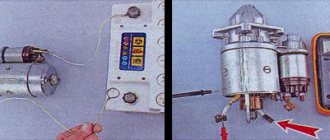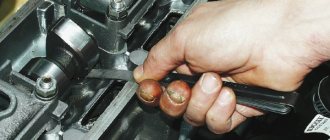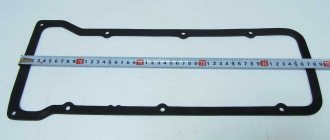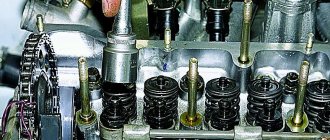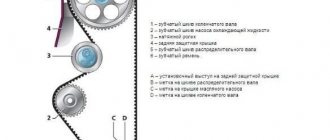PROCEDURE FOR ADJUSTING VAZ 2107 VALVES - STEP-BY-STEP INSTRUCTIONS
When everything is ready, you can begin direct regulation. Before mastering the procedure, you should understand the structure of the gas distribution mechanism and find out where the thermal gap is located that should be adjusted. The valves on the VAZ 2107, in fact, like on the vast majority of automobile engines, are located at the top, that is, the valve closes the hole located above the piston.
For each cylinder there are two valves: an inlet for supplying a combustible mixture and an outlet for removing exhaust gases. The clearance in the cylinder head opens due to the action of the camshaft cams. The camshaft is located above the valves and has its own eccentric cam for each of them, which transmits movement to the valve stem through a special lever. The gap between the cam (the point opposite the eccentric) and the lever should be adjusted.
Now you need to take two open-end wrenches for “13” and “17”, as well as a dipstick. The valves are regulated in accordance with a certain order, for which they are numbered from the front of the engine.
The VAZ 2107 valves are adjusted as follows:
1. insert the probe between the cam and the lever of the 8th and 6th valves alternately; 2. if the probe passes with little effort, then the gap corresponds to the norm; 3.unimpeded passage or sticking of the probe indicates the need for adjustment; 4. fix the head of the adjusting bolt with a wrench set to “13”, release the lock nut using a wrench set to “17” and turn the bolt in the desired direction to increase or decrease the gap, tighten the lock nut and check the gap. It is necessary to proceed in this way with each valve, each time turning the crankshaft 180° from the previous point. This operation corresponds to turning the camshaft by 90°. With each turn it is necessary to adjust the following numbered valves:
1) 180° - 4th and 7th; 2) 360° - 1st and 3rd; 3) 540° - 5th and 2nd. The procedure for adjusting the valves of the VAZ 2107 must be strictly followed, otherwise the settings of the gas distribution system can be completely disrupted. After each valve has been checked, it is necessary to turn the crankshaft several times and check the clearances again. It is necessary to ensure that the probe enters each of the gaps with absolutely the same force.
The procedure for adjusting valves on a VAZ 2107 with your own hands
The 8-valve engines that were installed on the Zhiguli Classic from time immemorial until they left the assembly line in 2012 were not equipped with hydraulic compensators. Therefore, adjusting the valves of the VAZ 2107 is part of the routine maintenance of these cars. You can do it yourself. Compliance with this requirement does not depend on the injection system (carburetor or injector).
Normal operation of the timing belt is impossible without observing the gas distribution phases. Violation of the factory clearances even on one pair of valves leads to inefficient combustion and poor removal of crankcase exhaust. The engine begins to chug, rev and make strange sounds (metallic knocking) during operation. If these symptoms occur, it is time to adjust the valves.
Preparatory activities
Unscrew the air filter cover by unscrewing the three fastening nuts on top and remove it. After this, pull out the filter element and tighten 4 more nuts that secure the filter housing to the carburetor. Be careful not to lose the nuts, which could easily fall into the carburetor chamber, as it will be very difficult to get them out later. The housing is removed and set aside.
Disconnect all hoses that pass through the cylinder head, plus unscrew the manual throttle control drive, then disconnect the cable. It is highly recommended to remove the distributor cover; it may interfere with inserting the dipstick into the valve mechanism clearance.
Before adjusting the valves, it is recommended to adjust the chain tension if it is loose or this procedure has not been carried out for a long time. To do this, use a 13mm wrench to loosen the special tensioner on the cylinder head and turn the crankshaft two to three turns in the direction of travel. The tension mechanism will automatically adjust, after which you must immediately tighten the tensioner.
Remove the valve cover of the VAZ 2106 car by unscrewing all the nuts around the perimeter. Don't forget to remove the old gasket. Now set the first cylinder to top dead center. The countdown is from the radiator grille. To do this, turn the crankshaft in the direction of travel until the mark on its pulley and the oil seal cover coincide. Please note that there are three marks on the cover, but you should use the longest one as a guide. To make sure that this is exactly the right stroke, there is another mark on the camshaft pulley in the form of a bold dot, which should be in the highest position and coincide with a special protrusion on the bearing housing.
What will happen if you do nothing?
Improper combustion causes increased wear on almost all engine parts.
If the valve clearance is greater than desired, the camshaft cam will hit the actuator arm and valve stem. And as a result, they all wear out quickly.
If the gap is small, the valve does not sit entirely on the seat. Hot gases from the combustion chamber penetrate into the resulting gap. As a result, the exhaust valve burns out, the seals wear out, oil starts to burn and other joys begin. Therefore, if symptoms appear, do not waste time. Adjusting the valves of the VAZ 2107 is a must.
About choosing styli
Uneven knocking noises in the area of the upper part of the valve cover indicate increased clearances. According to the instructions for setting the VAZ-2106 valves, they can be adjusted. The gaps are changed using special feeler gauges for classic VAZ models. These probes are wide. The standard set of feeler gauges is narrow and cannot cover the entire width of the gap in the operating area of the pressure levers and camshaft cams. This will not allow you to accurately determine whether the gap is correct. On the case in which the dipstick is sold, there is a diagram for adjusting the valves in the form of a convenient table.
Symptoms
The engine reports any malfunctions in advance by uneven operation. Among the main signs of valve clearance violations:
- metallic knocking when the engine is running;
- deterioration of acceleration dynamics;
- tripping at idle;
- increased fuel and oil consumption;
- “breathing” effect on carburetor cars.
First of all, pay attention to the knock. Other signs often indicate simpler malfunctions: incorrect ignition, a carburetor that requires adjustment, failure of one of the sensors (on the injector), etc.
Do-it-yourself valve adjustment
Adjustment sequence table
Adjusting the valves is a simple procedure; you can easily do it yourself at home. The order of setting the gaps depends on the injection system: a carburetor is installed or an injector.
Please note that on a hot engine, the valves can be adjusted in pairs: 1st cylinder with the 4th, and the 3rd with the 2nd. At this point, the valves are in overlap, the nose of the cam faces sideways and not up, intake and exhaust can be adjusted simultaneously
Carburetor cars
- remove the air filter housing, disconnect the choke and gas hoses, do not remove the carburetor;
- remove the cylinder head cover (you will need a “ten” key);
- use a 0.15 mm calibration feeler to check the current gaps: according to factory specifications, the feeler gauge should fit between the cam and the lever with little effort;
- if the gap on some valves is different (the dipstick does not fit in or, on the contrary, hangs out), make an adjustment.
Using a feeler gauge to adjust gaps
Valve adjustment order: 8-6 (set TDC for cylinder 4 according to the mark on the crankshaft pulley), 4-7 (rotate 180 degrees), 1-3 (rotate another 180 degrees), 5-2 (and another 180 degrees ).
To facilitate the procedure in the future, when disassembling the engine, it is recommended to mark the TDC position marks for each cylinder on the camshaft pulley.
Injector
The process of adjusting the valves on the “seven” with an injector is similar. It is also easy to do it yourself. The only difference is that you need to disassemble or disconnect to access the cylinder head cover:
- hoses going to the fuel rail;
- air filter tubes;
- accelerator cable.
Further actions are similar.
Adjusting the valve clearances on a VAZ-2107 with a carburetor or injector can be done not with a feeler gauge, but with the help of a special adjustment rail and a micrometric indicator. In this way, you can set the gaps with factory accuracy without “dancing with a tambourine.” After carrying out these measures, the engine should run like a clock. Do not forget to check the compression in the cylinders after finishing the work. This will help assess the condition of the engine.
Adjusting the valves should be combined with replacing the cylinder head cover gasket. This is the weak point of VAZ cars. It rarely lasts long after removal.
How to set the gap correctly?
Adjusting the VAZ-2106 valves with your own hands requires strict adherence to the sequence of actions and careful preliminary preparation.
Tools
First of all, make sure you have the necessary tools:
- socket wrenches;
- screwdrivers equipped with a flat blade;
- adjustment probe or micrometer;
- crankshaft turning key.
The adjustment sequence and instructions can also be found on the probe cover. Since the tool in question has standard parameters, and its thickness is 0.15 mm, its width does not cover the entire gap, and its use for fine tuning is not advisable. Moreover, the accuracy of adjustment with this tool decreases even more, since over time the gap width is deformed due to wear of cylinder head seats, valves and other parts.
Preparation
First of all, make sure that the battery is disconnected, otherwise you risk shorting out the wiring.
- There should be supports under the rear wheels, activate the neutral speed mode.
- Open the hood, wait until the engine cools down, otherwise there is no hope for accurate adjustment, and the risk of getting burned increases.
- Buy a rubber gasket under the cover; it will not deform when exposed to high temperatures. If you choose the old part, oily smudges will appear on the lid.
- If necessary, remove the gas pedal cable along with the carburetor cover.
- Get rid of the cover bolts, use a 10mm wrench for these purposes, make sure that the washers under the bolts are not lost.
Timing chain tension
After preparation, you must also make sure that the timing chain tension is at the optimal level and adjust it if necessary. Stretching the chain contributes to increased wear, the appearance of tapping sounds during engine operation, and disruption of the timing belt functionality.
There are two ways to check.
- Remove the engine from the protective casing, insert a screwdriver into the chain and try to bend it in two places where there is a little free space. With optimal performance, you won’t succeed and the chain won’t bend.
- Listen to the engine running when active. If noises are clearly audible, but a short activation of the gas eliminates them, the tension has weakened.
To adjust the tension, use a special tensioner.
Adjusting valves on VAZ 2107
“Classic” engines do not have hydraulic compensators in the timing belt, so adjusting the valves of the VAZ 2107 is a mandatory element of regular vehicle maintenance. The work is simple and can be done independently. The special tool required for adjustment is quite accessible and does not require special qualifications to use.
Adjustment sequence
So, we aligned the mark on the camshaft with the bevel on its cover and checked that they matched the knees. shaft Additionally, you can check the correct installation using the distributor slider. Its contact protrusion should be directed towards the output of the high voltage wire of the 4th cylinder.
If all marks match, you can begin checking and adjusting.
The procedure for adjusting the valves of the VAZ-2103 is given in the table:
The procedure for adjusting the valve mechanism of the VAZ “Classic”
| Knee rotation angle. shaft | Adjustable valves |
| 8, 6 | |
| 180 | 4, 7 |
| 360 | 1, 3 |
| 540 | 5, 2 |
Why adjustment is needed
When heated, engine parts, like any physical body, expand. This is especially true for elements of the gas distribution mechanism. The main timing parts - the valves - are in direct contact with the hot gases in the cylinder, opening and closing the intake and exhaust ports. The tightness of valve closure affects engine compression, efficiency and power.
The valves close under the influence of special springs, and to open they are pressed by rockers - levers driven by camshaft cams. When the rocker is not pressing on the valve stem, there should be a thermal gap between it and the camshaft. Why is valve clearance needed on VAZ 2107?
This is interesting: How to apply varnish to a car after painting
When the engine heats up, the length of the valve stems increases especially strongly (the larger the linear dimension, the greater the absolute value of thermal deformation). If in a cold state the parts fit tightly, when heated the rod will be constantly pressed, the valve will not close the window, which will lead to gas breakthrough. This threatens, in addition to reducing efficiency, burnout of the valve plates and engine breakdown. Therefore, there should be a gap of 0.15 mm between the rocker and the camshaft of a cold engine.
If the gap is greater than what is provided, the valves do not open well and the mechanism knocks; if it is less, the valves remain slightly open when this is unacceptable.
Over time, parts wear out and wear appears on the camshaft cams, rockers and valve stems. Therefore, owners of cars that are not equipped with hydraulic valve clearance compensators have to regularly check and adjust the timing belt clearances.
Adjustment
Now let's move on directly to the adjustment work. During the operation of cars of this model, it was possible to develop an algorithm that allows even beginners to adjust the valves. For convenience, we provide step-by-step instructions for setting up valves on a VAZ-2106.
When the position of the crankshaft according to the marks is saved, you need to check the thermal clearance of cams 8 and 6 on the camshaft. An important factor is that the gap is calculated from the star mark, which is closer to the windshield. It should be counted from this cam. Then a dipstick is installed under the camshaft above the rocker. If it passes freely, loosen the nut of the rocker where the measurements are taken. To eliminate the risk of scrolling, loosen the nut by 13. Then tighten the nut by 17 and measure the gap again. You need to get a result when the probe fits tightly into the gap and does not bend. When the result has been achieved, move on to the next cam.
Then the engine crankshaft is cranked. The markers should be at the 9 o'clock position. In this case, the mark on the sprocket must coincide with the one on the crankshaft pulley. Adjust the 4th and 7th cams. The adjustment process is carried out similarly to the adjustment of the 8th and 6th cams.
Next, rotate the crankshaft 180 degrees. The mark on the star will be at the 6 o'clock position. There is a mark on the crankshaft pulley. It should match the one on the star. This position allows you to adjust the 1st and 3rd cams. By turning the crankshaft to the 3 o'clock position, we open access to adjust the 5th and 2nd cams.
At the last step, the engine is cranked by the starter. Afterwards all gaps are checked. If the gaps are normal, then tighten all the nuts and assemble all the dismantled elements.
Preparatory work
Before starting the adjustment, you should perform the following operations:
- remove the air filter housing from the carburetor;
- remove the pipes and wires that prevent the dismantling of the timing cover;
- unscrew the nuts securing the timing cover;
- remove the timing cover.
When access to the valves is ensured, you can begin adjusting the thermal clearances. It should be remembered that the gap value of 0.15 mm was set by the designers for a cold engine. Therefore, before carrying out work, you must wait until the engine has cooled down. In addition, working on a hot engine can cause burns.
Adjusting the valves on a VAZ 2107 carburetor and on an injection model is absolutely no different. The only exceptions are engines on which hydraulic clearance compensators are installed. In this case, no adjustment is required.
Features of adjustment 2107 injector
- Firstly, there is no slider on the injection model, so the rotation angle can only be set along the camshaft (the same as for the carburetor model)
- Secondly, there is no need to remove the air filter housing to gain access to the cylinder head cover (unlike the carburetor model)
- Thirdly, to turn the crankshaft on an injection model, you won’t be able to use a 38mm wrench. You can jack up the rear wheel, put the gearbox in high gear and change the crankshaft angle by turning the rear wheel.
How to adjust valves on a VAZ 2107
The procedure is as follows:
- Check the chain tension and tighten it if necessary. If the chain is loose, the valve clearances will not be adjusted correctly.
- Turn the crankshaft with a wrench so that the mark on the pulley aligns with the long mark on the front engine cover. Make sure that the timing phase is not shifted (the marks on the sprocket and the camshaft cover match).
When the timing belt and crankshaft are aligned to the marks, you can begin adjusting the thermal clearances of valves 6 and 8.
Adjusting the gap is done as follows:
- Using a 17mm wrench, loosen the tightening nut (locknut) of the valve adjusting bolt;
- insert a dipstick (0.15 - intake valves, 0.20 - exhaust valves) between the camshaft and the valve pusher;
- set the required gap by turning the adjusting bolt with a key to 13;
- While continuing to hold the adjusting bolt, tighten the locknut;
- check the gap with a feeler gauge;
- If the gap is broken when tightening the locknut, the adjustment must be repeated.
After adjusting the valves, all that remains is to reinstall the timing cover and other parts. The machine is ready for use.
All valve train parts
1 - valve; 2 - retaining ring; 3 - guide sleeve; 4 — oil deflector cap; 5 — support washer of the outer spring; 6 — support washer of the internal spring; 7 — internal spring; 8 — outer spring; 9 — spring plate; 10 - crackers; 11 — valve drive lever; 12 — lever spring; 13 — adjusting bolt; 14 — lock nut of the adjusting bolt; 15 — bushing of the adjusting bolt; 16 — locking plate of the lever spring.
The procedure for adjusting the valves of the VAZ 2107
As mentioned above, with the marks on the crankshaft pulley and the front engine cover aligned, you can adjust the clearances of the 6th and 8th valves installed on the 3rd and 4th cylinders. Next, you need to rotate the crankshaft with a special key to change the position of the camshaft. The camshaft rotates twice as fast as the crankshaft, so the latter must be rotated a maximum of 540 degrees, which corresponds to a camshaft rotation of 270 degrees. Each pair of valves is adjusted after turning the camshaft 90 degrees:
- 0 degrees - 6 and 8 valves;
- 90 degrees - 4 and 7 valves;
- 180 degrees - 1 and 3 valves;
- 270 degrees - 5 and 2 valves.
The valve adjustment tables for all “classics” are similar.
Step-by-step instruction
The procedure for adjusting the VAZ 2106 valves is as follows (table below):
The valve numbering order is from the windshield towards the radiator.
In the initial position, valves 6 and 8 are adjusted.
Then the crankshaft is rotated 180 degrees and the next pair of valves is adjusted.
Then another rotation: 360 degrees to adjust the next pair.
And the last rotation is 540 degrees to adjust the last pair.
The work itself is carried out as follows:
- Park the car on a level, bright place. You should have enough space on either side of the motor. You will have to work for a long time, so the conditions must be comfortable.
- Wait until the engine cools down. It should not exceed the air temperature around.
- While the engine is cooling, prepare a set of tools: a set of wrenches, a dipstick, a crankshaft wrench, a flathead screwdriver, a new valve cover gasket.
- Check the timing belt tension. If necessary, adjust the belt tension.
- Open the air filter cover and remove the filter itself.
- Disconnect all pipes from the filter
- Remove the choke cable.
- Remove the accelerator linkage
- Remove the cylinder head cover.
- To make it more convenient to work, it is also better to remove the ignition distributor cap.
- Typically, when the timing belt is properly tensioned, the marks on the pulley and on the oil seal should match. Check it. There should be a pulley mark near the longest mark on the distributor. The mark on the camshaft should coincide with the protrusion on the VAZ valve cover. If this is not the case, rotate the crankshaft until the marks align. This will ensure that the piston is positioned in the fourth cylinder during the compression stroke.
- We place the dipstick under the camshaft a little higher above the rocker. The probe should not penetrate easily. If it fits easily, then you need to loosen the nut 17 on the rocker. Then the nut at 13 is loosened. The nut at 17 is tightened and a new measurement is taken using a probe. The feeler gauge should fit tightly into the gap, but not bend.
- We adjust the remaining pairs of valves using the described method. (adjustment order and crankshaft rotation angles)
- Finally, you need to crank the crankshaft using the starter and measure all the gaps again. If the adjustment is made correctly, tighten the nuts.
- Reassemble in reverse order and replace the valve cover gasket.
- To make the correct adjustment, you need to use special probes that are designed for Zhiguli engines. They differ from ordinary ones in their large width. Since standard feeler gauges for modern engines are small, they cannot measure the entire width of the gap. As a result, you will lose the opportunity to correctly measure the size of the gap.
- If it is difficult for you to remember the adjustment order and crankshaft rotation angles, look for a diagram in the dipstick cover. Typically, manufacturers apply it directly to the probe, which makes work easier. If you are unlucky and could not find the diagram, you can simply print this article and take it with you to the garage.
- The most suitable temperature for correct adjustment is 20 degrees Celsius. If the adjustment is carried out in winter, the engine can be slightly warmed up to the specified temperature.
- Some people use a distributor slider for convenience during adjustment. To do this, they remove the cap and monitor the slider on the distributor. The degree of rotation of the slider is different here. Each subsequent pair of valves is adjusted after turning the slider by one quarter (or 90 degrees). You can make your own marks with paint or chalk.
- If you use gas as fuel, then the gaps need to be set a little larger than usual.
This is how you can easily and naturally adjust the valves on a VAZ 2106 with your own hands. And although most car enthusiasts entrust this work to service station specialists, you can adjust the valves yourself. An engine with adjusted valves will run quieter and more efficiently. The procedure will take some time, but will save a significant amount of money if you do it yourself.
Adjusting valves on a VAZ 2107 by micrometer
Instead of a feeler gauge, a micrometer mounted on a special rail is used to adjust the valve clearance. With its help you can control the amount of free play of the rockers. A gap of 0.15 millimeters corresponds to a rocker free play of 0.52 millimeters.
The rack has special nuts that allow it to be screwed onto the camshaft mounting studs. This allows it to be installed sequentially over each pair of valves. It is necessary to tighten the rack fastening nuts well so that it does not swing during measurements. After this, you need to fix the micrometer (indicator) on the rail so that it rests against the edge of the rocker that presses the adjustable valve.
To check the clearance, you need to lift the rocker cam with a special grip or finger and check the amount of free play using the arrow of the device. If it is not equal to 0.52 mm, then it should be set in the same way as when adjusting using a feeler gauge.
This adjustment method is more accurate and reliable. The feeler gauge, passing between the rocker and the camshaft, ignores the possible gap that appears as a result of wear on the parts.
The micrometer determines the actual amount of free play of the rocker; in addition, it is easier and more reliable to navigate by the indicator readings than by the free movement of the feeler gauge. This allows you to adjust the clearances in the valve mechanism as accurately as possible.
Preparation for work and disassembly
I would like to immediately note that this procedure requires time and is conditioned by an understanding of the process. There is a certain algorithm for implementing this task. To begin with, place your car on a level surface and provide free and well-lit access to the engine compartment.
The engine must be cooled and at ambient temperature.
Before starting the adjustment process, you need to prepare:
- a set of different wrenches in sizes “10”, “13”, “14”, “17”;
- 0.15 mm feeler gauge;
- key for turning the crankshaft;
- screwdrivers;
- spare valve cover gasket.
The disassembly process includes removing the air filter, disconnecting all pipes from the air filter cover, removing the choke cable, accelerator linkage and cylinder head cover.
It is advisable to remove the distributor cover so that it does not cause inconvenience during the adjustment process. There will be marks on the pulley and oil seal cover. The crankshaft must be turned until they coincide.
Adjusting valves VAZ 2107 carburetor
Volzhsky auto has reliable and easy-to-maintain gasoline engines with a displacement of 1500 cm 3 . On such power units, after reaching a certain mileage, the thermal gap is checked and adjusted. This process is usually accompanied by replacement of the gasket and repair of individual engine components, within the framework of the routine maintenance provided for in the service book.
During operation of the power unit, its parts heat up, but if there is no gap between the valve lever and the cam, they knock on the seat. This malfunction does not allow the carburetor to be adjusted correctly and leads to increased fuel consumption. Careful adjustment and, if necessary, replacement of failed parts will help eliminate the problem.
Regulation of the gas distribution mechanism
To perform service work, you will need an equipped garage box, a set of plumbing tools and a calibrated one. Maintenance and repair of the timing belt is also carried out if the valves knock with a sharp increase in engine speed. In this case, it is not necessary to dismantle the carburetor; it does not interfere with checking and setting the correct gap in the gas distribution mechanism.
Repair and adjustment of valves is carried out on a cold engine at an ambient temperature of about 20 °C. This will require replacing the head cover gasket. The work is performed in the following sequence:
- The carburetor and other units are inspected, and the air filter housing is removed from it.
- Using a “10” wrench, the fastening bolts are unscrewed and the heads are dismantled.
- We set the gearbox to the neutral position and, using a special key, set the piston of the first cylinder to the top dead center position.
- Using a calibrated feeler gauge 0.15 mm thick, check the gap between the cam and the lever in accordance with the table.
- If the indicator does not correspond to the standard, then adjustment is made using two keys, one is released and the lock nut is held, the other is screwed in or the stop is unscrewed.
- Rotate the crankshaft 180° and check the gap in the next pair of parts.
This is interesting: Which carburetor is better for the UAZ engine 417
The operation is repeated four times for all eight valves, further repairs include replacement and installation of a new gasket. When attaching the cover, the bolts are tightened in a certain order. At the end of this process, the air filter housing is installed on the carburetor.
IN TWO STEPS
Author: /alekseyNN/ Published: 1793 days ago (July 9, 2014) Blog: CAR CLUB Heading: TUNING, IMPROVEMENT, AUTO WORKS0 Votes: 0 Rating statisticsIN TWO STEPS
Adjusting the valves of Zhiguli engines is a simple matter, but for some it is profitable and therefore very exciting. Experienced craftsmen set gaps in just half an hour with less effort than required by the instructions. Valentin GRIGORIEV tells how they do this.
The camshaft is in position for adjusting valves 1,2,3,5. The factory repair manual suggests performing this operation in four steps: adjust the clearance of two valves, turn the crankshaft 180° - and so on three more times. However, you can do everything in two. VAZ engines (like many other in-line four-cylinder engines) have a cylinder operating order of 1–3–4–2. That is, the working stroke in the first, after 180° along the crankshaft - the working stroke in the third, after another 180° - in the fourth, and so on. In Fig. 1 shows the camshaft and crankshaft. If the “configuration” of the latter is quite simple (its “model” can be easily made from a piece of wire), then the cams on the camshaft are located “cunningly”. This is explained by their function - to provide the necessary valve timing: if formally each stroke of the crankshaft rotation angle is 180°, then each valve is open longer - 232°, and the opening of one is shifted relative to the other (Fig. 2).
Fig.1. Elbow and distributor
VAZ-2101…2106 shafts. The intake valve begins to open 12° earlier than the piston reaches top dead center (TDC) on the exhaust stroke. And after it passes the bottom dead center (BDC), the intake valve (already during the upward stroke of the piston) continues to close for another 40°. The exhaust valve also “captures” part of the neighboring strokes. Moreover, there is a moment of “overlapping” of the valves: near TDC at the end of exhaust, both valves are simultaneously slightly open. Without going into the intricacies of the gas distribution process, I will note: it is during such phases that the engine is able to develop the declared power.
Compression check and troubleshooting
This procedure allows you to assess the condition of the parts of the cylinder-piston group. It shows quite accurately whether engine repair, replacement of worn parts, tuning and adjustment of the gas distribution mechanism is required. In some cases, the situation can be corrected by grinding in the VAZ 2107 valves, which restores the tightness of the joint between the parts.
The measurement is carried out with a special pressure gauge with the spark plugs turned out, and it is advisable to disconnect the carburetor from the fuel pump. This will prevent it from flooding with fuel and make starting easier. The test is carried out with the throttle valve fully open, so that the carburetor creates minimal resistance to air flow. The lowest indicator demonstrates the degree of maximum wear of the cylinders.
If the difference in compression values for different cylinders is above a certain value, which means a large gap between the cylinder wall and the piston.
Engine repair and subsequent valve adjustment will be required. During the work, compression and oil scraper rings are usually replaced.
Frequency adjustment
The procedure in question should be performed after every 30 thousand km according to the manufacturer’s recommendations. The condition of the gaps must be checked three times more often. If you dismantled the cylinder head and replaced its gasket, the procedure for adjusting the gap is advisable in any case, even if the mileage has not reached the extreme mark. If you ignore this need, you will soon find out what it is like to drive under the above circumstances, since the clearances of different valves will be unequal.
Purpose of valves in an engine
During operation, the engine consumes air and fuel and emits exhaust gases. The valves allow air-fuel mixture to enter the cylinder (through the intake valve) and exhaust gases to be removed (through the exhaust valve). The alternation of intake and exhaust cycles is called the engine duty cycle. It consists of four measures.
- Inlet. Inlet valve is open. The piston moves downwards and, due to the vacuum created in the cylinder, carries with it the air-fuel mixture, which enters through the open intake valve.
- Compression. Both valves are closed. The piston moves upward (toward the spark plug) and compresses the air-fuel mixture.
- Working progress. Both valves are closed. The spark plug produces a spark that ignites the air-fuel mixture. During combustion of the air-fuel mixture, a lot of gas is formed, which pushes the piston down.
- Release. The exhaust valve is open. The piston moves up and pushes exhaust gases out of the cylinder through the open exhaust valve.
The engine operating cycle consists of four strokes, during which the working mixture enters, is compressed and burns, then the exhaust gases are removed
Video: how the engine works and the purpose of the valves
The meaning of valve adjustment
The opening of the valve is controlled by the camshaft cam. When the engine is running, the valve heats up and elongates, which can cause it to not close completely. To compensate for this elongation, there is a gap between the valve and the camshaft cam . The point of adjusting the valves is to set the required value of this gap.
Signs of improper valve adjustment
Signs of improperly adjusted valves include:
- Extraneous metallic knocking noise from under the valve cover.
- Reduced engine power.
- The smell of pure gasoline in the exhaust gases.
Adjusting the valves on VAZ 2107 cars is mandatory after repairing the gas distribution mechanism, as well as after a mileage of 10–15 thousand kilometers.
Video: operating principle of the gas distribution mechanism
Features of timing belt
For example, the timing belt is with the valves up and the camshaft. The engine's timing mechanism was a chain mechanism, which was present on all models.
A special feature of the timing system is the use of pressure levers, also known as rocker arms. They are located between the camshaft and the end of the valve stem. This means that the cam does not act directly on the valve, but through the rocker arm. The pendulum also allows you to adjust the thermal gap.
This clearance is required to accommodate changes in valve component geometry due to heat causing metal expansion. If such a gap did not exist, the valve timing would be shifted due to heating of the drive system. Simply put, when heated, due to the expansion of the metal, the valves do not close completely, which leads to a loss of compression and, as a result, a drop in power.
The list of work associated with servicing the drive units of these models includes such an event as valve adjustment. This is due to the design features of the valve mechanism. During operation, the working surfaces of valve heads, valve levers and camshaft cams wear out, which leads to a violation of the thermal clearance.
Fortunately, the same design is quite simple, so the adjustment work is quite simple and can be done with your own hands. It is only important to know the sequence of operation and the sequence of valve adjustment in the “Classic”. It is worth noting that the work is identical for almost all models, therefore the sequence of adjusting the valves of the VAZ-2101 and, for example, the VAZ-2105 is the same, only on the VAZ-2107 it is slightly different.
Since for most models the operating principle is identical, all Zhiguli models related to the “Classics” will be presented below.
The first and main principle of operation is to perform only on a cooled engine. This is due to the same expansion of the metal. If the valve adjustment on a VAZ-2102 or any other model is performed on a warm unit, the operation does not give a positive result, since when it cools, the metal will return to its original form and the gap will not match. normal, then just increase it.
It is also important to know when to adjust the VAZ-2105 valves. A real sign that the valve train is out of adjustment is a metallic clanging sound coming from under the hood when the engine is running. Moreover, its intensity changes in proportion to the increase or decrease in trade turnover.
The valves on the VAZ-2104 should also be adjusted during any repair of the cylinder head associated with the removal of the camshaft.
Adjusting valves on a VAZ 2107
Adjusting the valves on the VAZ 2107 is not difficult. However, you will need some spare parts and materials, as well as detailed instructions.
Required tools and materials
Before you begin adjusting the valves, you must acquire the following tools and materials:
- A set of feeler gauges for adjusting gaps (or a micrometer and a rod). This is the main tool in the work. It must be of good quality; you should not buy probes from a dubious manufacturer.
- Set of medium-sized open-end wrenches (10–19 mm).
- Valve cover gasket. It is better to choose a good gasket manufacturer: Corteco or Elring.
- Clean rags or paper towels.
A feeler gauge set is the main tool for adjusting valve clearances.
Instructions for adjusting valve clearances
On absolutely any classic engine, including the VAZ 2106, the thermal valve clearances must be adjusted from time to time. If this is not done, then over time some valves may be clamped, or, on the contrary, the gap will be too large and they will knock. To avoid this, adjustments must be made in a timely manner. To begin with, I will give a list of tools that will be needed to complete this work with the VAZ 2106.
- Open-end wrench 13
- 17 open-end wrench
- A set of probes, or rather, we need exactly one probe, 0.15 mm thick
- And also a list of tools needed to remove the valve cover





